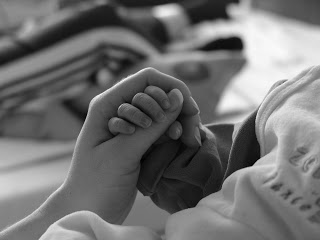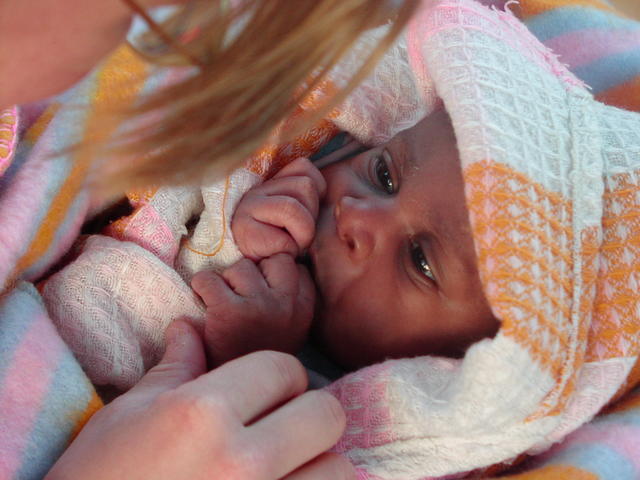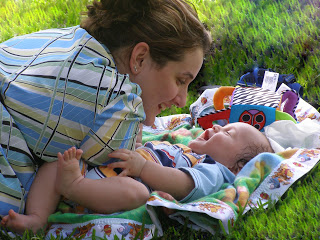Whether or not your first days as a parent were spent breastfeeding on the couch watching Oprah, like me or not, psychologists now understand that the bonding between a parent and child (or caregiver and child) occurs in a myriad of ways. The important thing is that bonding happens! Without developing the ability to care about ourselves and each other…we rarely possess the kind of heroic heart we need to thrive in life.
Good news from psychoneurobiology research: the underlying processes associated with bonding now reassures parents that skin-to-skin contact is also one of the primary triggers for oxytocin’s release. Oxytocin being the stock for the chemical soup that is parental love. Simply holding our child triggers a release of love-inducing chemicals (opiods, for example—those pleasure-giving, rewarding neurochemicals that calm us, relieve pain, and generally reward life-sustaining behaviors).
 It has also now been established that though breastfeeding has obvious benefits for both mother and child; it is the association between a mother’s antecedent sensitivity to her child which lends breastfeeding its secondary social attachment benefits. Noriuchi, Kikuchi, & Senoo’s (2008) study showed that there is a strong association between a mother’s sensitivity to her infants’ cries (versus smiles) and her decision to breastfeed. They concluded that observation as biologically significant and related to our ability to adapt to the specific demands associated with infant care. Other researchers, too, have concluded that it is the quality of mother-infant interaction at six months, rather than the type of feeding, that predicts security of attachment (Britton et al., 2006).
It has also now been established that though breastfeeding has obvious benefits for both mother and child; it is the association between a mother’s antecedent sensitivity to her child which lends breastfeeding its secondary social attachment benefits. Noriuchi, Kikuchi, & Senoo’s (2008) study showed that there is a strong association between a mother’s sensitivity to her infants’ cries (versus smiles) and her decision to breastfeed. They concluded that observation as biologically significant and related to our ability to adapt to the specific demands associated with infant care. Other researchers, too, have concluded that it is the quality of mother-infant interaction at six months, rather than the type of feeding, that predicts security of attachment (Britton et al., 2006). We can all cuddle our newborn baby while we bottle-feed, snuggle our newly adopted child, wipe the tears on our stepchild’s cheek, or hold our foster child’s hand. The more sensitivity and responsiveness a caregiver can show an infant, the more securely attached a child can become.
How do we know when we’re being sensitive and responsive enough? Our child usually stops crying (unless of course, colic or other medical issues need attending to). Infants, it turns out, are training us to be good parents as much as we are training them in the art of attachment.

As a parenting coach, I always make sure to assess whether or not the bonding between a parent and child was a difficult or easeful process. I ask how the couple managed the transition to parenthood, or how the individual adapted to his/her role as caregiver/adoptive, foster, or step-parent. My clients and I revisit any lingering questions, regrets, or concerns that may have impacted early parental bonding. In the case of any traumatic history impacting parent-child bonding, mental health/family counseling may be recommended. Then, if need be, we begin the process of revisiting those weaker links in the bond between parent and child to strengthen the connection.
It is never too late to strengthen the bond between a parent and child. The primary building blocks for secure attachment being emotional accessibility and responsiveness. Sometimes, however, admitting the areas where we could grow stronger as a parent takes the most courage of all! Yesterday, for example, when my daughter came bursting through the door after school and I was absorbed in writing a blog post on my computer, she let me know “It feels like there is an invisible wall between you and me when you are on the computer.” We’re still adjusting to having busier schedules and more technology in our lives now that my children are older. I’m also very focused when I’m writing. You can only imagine how much fun I was finishing my Doctoral dissertation! I later found a note written in my daily planner “hug me today” and “hug my brother” scheduled for tomorrow. Thankfully, my children offer me a daily wake-up call to live more in the present and make sure, as often as possible, to stop what I’m doing and offer my full attention to who they are, what they are up to, and prioritize what’s most important in life. Fortunately, sometimes healing a rift in a parent-child bond is as simple as closing the laptop and offering a hug!
How do you stay connected with your child and nurture your parent-child bond?
Sources:
Britton, J., Britton, H., & Gronwaldt, V. (2006). Breastfeeding, sensitivity, and attachment. Pediatrics, 118,
Gordon, I., Zagoory-Sharon, O., Schneiderman, I., Leckman, J. F., Weller, A. & Feldman, R. (2008). Oxytocin and cortisol in romantically unattached young adults: Associations with bonding and psychological distress. Psychophysiology, 45, 349–352. doi: 10.1111/j.1469-8986.2008.00649.x
Johnson, S. & Whiffen, V. (Eds.) (2003). Attachment processes in couple and family therapy. NY: The Guilford Press.
Noriuchi, M., Kikuchi, Y. & Senoo, A. (2008). The functional neuroanatomy of maternal love: Mother’s response to infant’s attachment behaviors. Biological Psychiatry, 63, 415–423.
 It has also now been established that though breastfeeding has obvious benefits for both mother and child; it is the association between a mother’s antecedent sensitivity to her child which lends breastfeeding its secondary social attachment benefits. Noriuchi, Kikuchi, & Senoo’s (2008) study showed that there is a strong association between a mother’s sensitivity to her infants’ cries (versus smiles) and her decision to breastfeed. They concluded that observation as biologically significant and related to our ability to adapt to the specific demands associated with infant care. Other researchers, too, have concluded that it is the quality of mother-infant interaction at six months, rather than the type of feeding, that predicts security of attachment (Britton et al., 2006).
It has also now been established that though breastfeeding has obvious benefits for both mother and child; it is the association between a mother’s antecedent sensitivity to her child which lends breastfeeding its secondary social attachment benefits. Noriuchi, Kikuchi, & Senoo’s (2008) study showed that there is a strong association between a mother’s sensitivity to her infants’ cries (versus smiles) and her decision to breastfeed. They concluded that observation as biologically significant and related to our ability to adapt to the specific demands associated with infant care. Other researchers, too, have concluded that it is the quality of mother-infant interaction at six months, rather than the type of feeding, that predicts security of attachment (Britton et al., 2006). 

